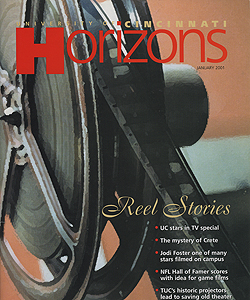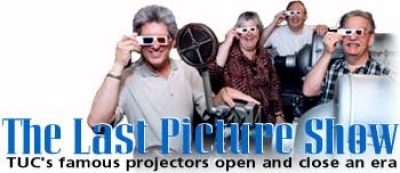By Deborah Rieselman
Cardboard 3-D glasses were still sitting on a shelf in the projection booth. A nearby box contained a shipping label addressed "Tangeman University Center, University of Cincinnati, attention Fred Schoenfeld." Yet Schoenfeld had graduated 33 years earlier, and the final 3-D movie in TUC was probably shown two decades ago.
It was summer 2000, and an amused Schoenfeld stood in the booth shaking his head at the way time had stood still in TUC's Great Hall. At first appearance, little had changed since the late 1960s when the projection booth was built to house the new projectors that Schoenfeld obtained from the New York World's Fair. Then again, everything had changed.
In the early '70s, the Great Hall was a newly renovated facility, filled to capacity for six different shows every weekend. In short, it was the campus hot spot. Unfortunately, by the '90s, it had reverted to a cavernous room that the majority of students bypassed with great regularity.
A few months ago, the students who knew the most about the Great Hall's rise and fall in popularity got together for a reunion. All four of them.
The most senior member of the group was Schoenfeld, Eng '67, who first saw the state-of-the-art projectors in the Bell pavilion at the World's Fair in 1965. After the fair closed, he got Cincinnati Bell and AT&T to donate a pair of 16 mm projectors to the university.
Next, he and classmate Ted Young, CAS '66 & '70, installed the pair of projectors (two were needed to switch reels mid-movie) and built both a sound system and a control system. In the end, the university spent a couple hundred dollars for a system worth $11,000 in 1966 prices.
Once everything was operational, they trained Mark Harlow, Eng '71, MS (Eng) '76, to join them as a projectionist and inaugurated a film series. After Schoenfeld graduated, Young trained Karen Webb, A&S '73, MA (A&S) '75, as a replacement. Young, Harlow and Webb continued to show films in TUC long after graduation. Harlow hung around so long that TUC director Larry Elsasser says he is still the first person anyone calls about the projectors.
Holding the hottest tickets on campus
Although Schoenfeld initially solicited the projectors on something of a whim, the Film Society that resulted from their installation literally changed student life on campus for more than a decade. From the early '70s and well into the '80s, TUC's Great Hall was the place to be on weekends. New films were shown three times on Friday nights, plus classic and foreign films were shown three times on Saturdays -- all to sold-out houses of 3,600 students every weekend.
"On Fridays, I'd have class all day, then eat at 5 o'clock to get ready to show a movie at 7 and another one at 9:30 and the last one at 12," Ted Young remembers. "I practically slept there."
"It was a very special time on campus," says Elsasser, the director since 1970. "We ran Cinemascope, just like a movie theater. You couldn't tell the difference . . . except for bad chairs.
"The students ran it very professionally. They even tried to show 'The Last Tango in Paris,' but (Hamilton County prosecutor) Simon Leis closed that one down."
The Film Society's popularity began to decline in the late '80s as videotape gained popularity and most movies could be seen in an average dorm room. Although the society still exists, films on campus today neither serve the same kind of purpose nor the same kind of audience they once did.
Nevertheless, the original World's Fair projectors still sit in the Great Hall with instructions in Schoenfeld's and Young's own handwriting. Knowing that TUC would temporarily close this spring for extensive renovations, Elsasser thought long and hard about what to do with the 16 mm projectors.
He concluded campus has little use for them anymore. Even vintage films once shown on 16 mm film can usually be obtained on standard VHS tapes today, he says.
As a result, the projectors went up for sale in December, Schoenfeld bought them back, and another campus era drew to a close.

 Past Issues
Past Issues